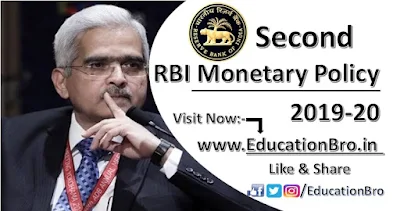 |
| RBI has announced Second Bi-Monthly Monetary Policy Statement 2019-20:- Point-to-Point Details |
RBI has announced Second Bi-Monthly Monetary Policy Statement 2019-20:- Point-to-Point Details
RBI Governor Shaktikanta Das has announced the Second Bi-monthly Monetary Policy Statement for
the year 2019-20. (June 6th 2019)
On the basis of an assessment of the current and evolving macroeconomic situation at its meeting, the Monetary Policy Committee (MPC) decided to:-
Reduce the policy Repo Rate under the liquidity adjustment facility (LAF) by 25 basis points to 5.75 per cent from 6.0 per cent with immediate effect.
Consequently, the Reverse Repo Rate under the LAF stands adjusted to 5.50 per cent, and the marginal standing facility (MSF) rate and the Bank Rate to 6.0 per cent.
The Cash Reserve Ratio (CRR) of scheduled banks unchanged at 4.0% of (NDTL).
Current RBI Policy Rates Given Below:-
Policy Repo Rate
|
5.75%
|
Reverse Repo Rate
|
5.50%
|
Marginal Standing
Facility (MSF) Rate
|
6.00%
|
Bank Rate
|
6.00%
|
Cash Reserve
Ratio (CRR)
|
4%
|
Statutory
Liquidity Ratio (SLR)
|
19.00%
|
RBI Monetary Policy Tools | Monetary Policy Instruments
These decisions are in consonance with the objective of achieving the medium-term target for consumer price index (CPI) inflation of 4 per cent within a band of +/- 2 per cent, while supporting growth.
Turning to the domestic economy, on May 31, 2019 the National Statistical Office (NSO) released quarterly estimates of gross domestic product (GDP) for Q4:2018-19 and provisional estimates of national income for 2018-19. GDP growth for 2018-19 has been estimated at 6.8 per cent year-on-year (y-o-y), down by 20 basis points from the second advance estimates released on February 28, pulled down by a downward revision in private final consumption expenditure (PFCE) and moderation in exports. Quarterly data show that domestic economic activity decelerated sharply to 5.8 per cent in Q4:2018-19 from 6.6 per cent in Q3 and 8.1 per cent in Q4:2017-18.
Gross fixed capital formation (GFCF) growth declined sharply to 3.6 per cent, after remaining in double digits in the previous five quarters. Private consumption growth also moderated. The drag on aggregate demand from net exports increased in Q4 due to a sharper deceleration in exports relative to imports. However, the overall slowdown in growth was cushioned by a large increase in government final consumption expenditure (GFCE).
Retail inflation, measured by y-o-y change in CPI, remained unchanged in April, at its March level of 2.9 per cent, with higher inflation in food and fuel groups being offset by lower inflation in items excluding food and fuel.
The April food inflation print showed an increase to 1.4 per cent from 0.7 per cent in March. Within the food group, vegetables moved out of nine months of deflation. However, three sub-groups, viz., fruits, pulses and sugar, remained in deflation in April, though the extent of deflation moderated. Among other food sub-groups, inflation in prices of milk, oils and fats, spices, non-alcoholic beverages and prepared meals moderated, while inflation in meat, fish and eggs prices ticked up.
The next meeting of the Monetary Policy Committee (MPC) is scheduled during August 5 to 7, 2019.







0 Comments